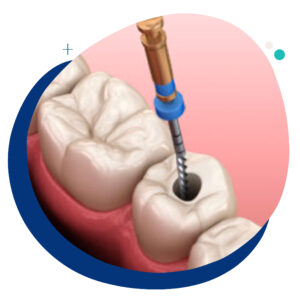Root Canal Therapy
Signs and Symptoms for Doing Root Canal Therapy:
- Acute pain when chewing or applying pressure to the tooth.
- Persistence of hot or cold sensitivity after the stimulus has been removed.
- Tooth discoloration or darkening.
- Localized gum swelling and tenderness.
- A lumpy area of gum tissue near the impacted tooth.
- Even after taking over-the-counter pain relievers, there is still pain or discomfort.
- An unpleasant flavor or odor in the mouth close to the injured tooth.

The Process
The procedure involves extracting the inflamed or infected pulp from the tooth’s center followed by cleaning and sealing the interior of the tooth. A general description of the steps required in root canal therapy is provided below:
- Anesthesia:
To make sure the patient feels at ease throughout the treatment, the dentist will numb the area around the tooth.
- Isolation:
To isolate the tooth and keep it dry, a rubber dam will be put around it.
- Access:
A hole in the top of the tooth would be made with a drill to get the pulp out.
- Pulp Removal:
Using specialized tools, the dentist will delicately remove the inflamed or infected pulp from the tooth’s canal.
- Filling:
To stop the infection from spreading, the inside of the tooth will be filled with a biocompatible substance.
- Restoration:
A filling or crown will be placed on the tooth for protection. The function and appearance of the tooth will be restored.
- Post-operative care:
The patient will be given instructions on how to take care of the treated tooth and what to anticipate. Depending on the complexity of the case, the root canal therapy procedure usually requires one or two dental visits. The majority of patients feel little to no pain during or after the procedure, and with proper care, the treated tooth can last a lifetime.
Dental Crowns
Following a root canal procedure, the tooth’s remaining structure may deteriorate and become more fragile, making it more prone to fracture. The remaining tooth structure is strengthened and stabilized by a dental crown that is fitted over it. Additionally, the crown aids in restoring the tooth’s size, shape, and appearance, which makes it simpler to bite and chew food. Additionally, the crown shields the tooth from further harm and keeps germs out of the root canal, preserving the tooth’s long-term health.
Dental Crown Placement
Two visits to the dentist are typically necessary for the placement of a dental crown. The following are the steps:
- Preparation:
The dentist will use local anesthesia to numb the tooth and the surrounding area and will remove any decay or damaged tissue. After taking impressions to create a model of the tooth, the dentist will reshape the tooth to make room for the crown.
- Placement of a Temporary Crown:
While the permanent crown is being created, a temporary crown may be put in place to protect the prepared tooth.
- Crown Construction:
The permanent crown is made to fit the prepared tooth using the impressions sent to a dental laboratory. Normally, this procedure takes a few days to a week.
- Placement of the Permanent Crown:
The dentist will place the permanent crown at the second appointment after removing the temporary one and making sure it fits correctly and appears natural. The crown will then be firmly secured in place.
The procedure for placing a dental crown is typically painless, and the temporary crown aids in keeping the tooth functional and protected while the permanent crown is being created. The dentist will answer any questions you may have and give you comprehensive instructions on how to care for the permanent crown and temporary crown.
Are Dental Crowns Long Lasting?
The material used, where the crown is placed in the mouth, the patient’s oral hygiene routine, and lifestyle choices all affect how long a dental crown will last. With the right maintenance and care, dental crowns can typically last between 5 and 15 years. While crowns made of porcelain or ceramic materials may last longer than those made of metal, they may also be more prone to breaking or chipping. Metal crowns, such as those made of gold or base-metal alloys, tend to be stronger and more resilient, but they might not match the color of the adjacent teeth.
A dental crown’s lifespan can be increased with regular checkups and cleanings, good oral hygiene practices, and avoiding habits like teeth grinding or clenching. To prevent further damage or the need for a replacement crown, it is crucial to see a dentist as soon as a crown becomes loose, broken, or otherwise compromised.



